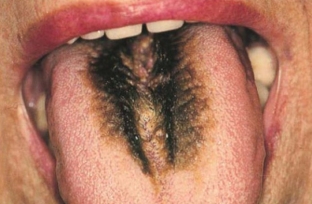Villous tongue causes serious fear in patients, and some of them even require serious psychotherapy to get rid of cancerophobia about this rather unusual disease. Black hairy tongue is most common in older men and occasionally in children. The disease is a hyperplasia and keratinization of the filiform papillae of the tongue, and sometimes these keratinized outgrowths reach a length of up to 3 cm, are painted in different colors from yellowish to almost black and look like hair. The causes of black hairy tongue are not exactly known, but the disease does not last long and has a good prognosis.
Why might a black hairy tongue appear
Hyperplasia of the filiform papillae on the tongue can develop for a number of reasons, although scientists are not unanimous about why a patient suddenly develops a black hairy tongue. Among the factors that can provoke this disease are the following:
- chronic gastritis, liver disease;
- exacerbation of chronic colitis;
- violation of epithelial metabolic processes;
- bacterial infection;
- long-term medication, especially antibiotics, sulfonamides;
- Riboflavin deficiency in the body;
- the influence of irritating elements (tobacco, alcohol, spices).
It is believed that under the influence of irritants contained in food, drinks or drugs, the patient develops a strong organ sensitization, manifested by a very specific tissue edema – there is hyperplasia of the papillae of the tongue and their keratinization. Some researchers point to the possible influence of a fungal infection on the occurrence of a black hairy tongue. But observations have shown that hyperplasia of the tongue & nbsp; papilla becomes a favorable environment for the development of candidal stomatitis, and fungal invasion is secondary in this disease.
Manifestations and troubles of black hairy tongue
The black hairy tongue does not cause pain and special complaints in the patient, most often the patient comes to the doctor because of the unusual appearance of the tongue. Complaints may include the following:
- slight itching on the palate;
- Gag reflex when talking;
- taste disturbance;
- dryness of the mucous membranes of the oral cavity;
- feeling of a foreign body in the mouth.
Altered areas with hyperplastic filiform papillae are usually located not on the entire tongue, but only in oval or triangular islands along the midline of the back of the tongue in the middle or back of it. In front and on the sides, the language does not change. The length of the modified papillae is approximately 1.5-2 cm, but can reach 3 cm, the thickness is about 1.5-2 mm, at the base it is thicker and yellowish, at the ends they acquire a color from brown to black. The color of the filiform papillae in a black hairy tongue is due to chromatogenic bacteria.

Treatment of black hairy tongue and possible prognosis
Sometimes manifestations of filiform papilla hyperplasia may spontaneously disappear, but without proper treatment, the black hairy tongue recurs after a while and may persist indefinitely.
Treatment consists, before in total, in the sanitation of the oral cavity, in the local application of keratolytics (solution of resorcinol, salicylic alcohol), injections of a solution of calcium chloride under the lesion. If papillary hyperplasia is severe and significantly impairs the patient's quality of life, their cryodestruction is indicated. The patient is forbidden to smoke, a sparing diet is prescribed. As a rule, the disease resolves in about 3 weeks, although longer cases have been described, the prognosis is favorable.









Add a comment